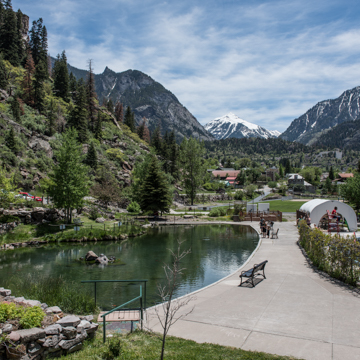For centuries Ute Indians resorted to the numerous hot springs in the Ouray area to soak away their aches and pains. The hot water kept nearby plants green all winter, attracting wild game, which provided an additional reason to seek out the springs. Bone-chilled, rheumatic miners sought out the magical waters as a cure for everything from miner's lung to impotence. The odorless water is piped in from a Box Canyon spring, which flows out of the ground at 156 degrees F., then is mixed with cold water for a small pool where bathers can soak at 101 to 115 degrees F. Three larger pools have incrementally cooler water, with the largest and coolest roped for lap swimming.
Tent cabanas which once lined the edge of the pool have been replaced by a bathhouse (1974), but the main pool, built in 1926, remains—a huge 250-by-150 foot oval ranging from 2 to 9 feet in depth. A smaller, adjacent pond, created by flooding some of the clay pits of Francis Carney's former brickyard, keeps goldfish in warm water year round. The spacious park around the pool features a bandstand, a visitors' center, and restored narrow-gauge D&RG caboose 0575 (1886).

